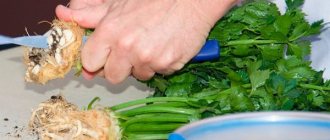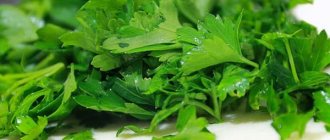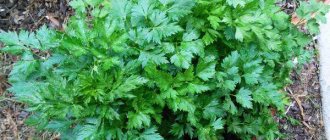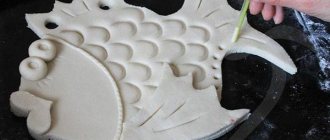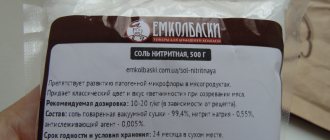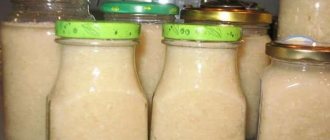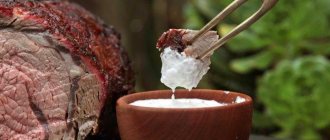Among all the well-known root vegetables, parsley root occupies a special place. "Tops", the greens of which are widely known, for. They are not so common, although they have excellent taste and aroma, have medicinal and health-improving properties, which is an important factor on the crest of a wave of healthy eating. Today I will tell you about the benefits and harms, the use of parsley root in cooking and other areas of life, as well as the beneficial properties and contraindications of the root for the human body.
Composition of the root and its beneficial properties
The nutritional value and chemical composition of 100 g of root in comparison with greens is shown in the table:
| Root | Parsley | |
| Calorie content | 51 | 49 |
| Proteins, g | 1,5 | 3,7 |
| Fats, g | 0,6 | 0,4 |
| Carbohydrates, g | 10,1 | 7,6 |
| Dietary fiber, g | 3,2 | 2,1 |
| Water, g | 83 | 85 |
| Organic acids, g | 0,1 | 0,1 |
| Ash | 1,1 | |
| β-carotene, mg | 0,01 | 5,7 |
| Vitamin B1, mg | 0,08 | 0,05 |
| Riboflavin (B2), mg | 0,1 | 0,05 |
| Choline (B4), mg | 7,7 | 12,8 |
| Pantothenate (B5), mg | 0,4 | 0,05 |
| Pyridoxine (B6), mg | 0,6 | 0,18 |
| Folates (B9), mcg | 24 | 110 |
| Vitamin C (main water-soluble blood antioxidant), mg | 35 | 150 |
| Vitamin E, mg | 0,1 | 1,8 |
| Biotin (vitamin H), mcg | 0,4 | |
| Phylloquinone (vitamin K), mcg | 164 | 1640 |
| Vitamin PP, mg | 1,3 | 1,6 |
| Macronutrients | ||
| Potassium, mg | 342 | 800 |
| Calcium, mg | 57 | 245 |
| Silicon, mg | 13 | 15 |
| Magnesium, mg | 22 | 85 |
| Sodium, mg | 8 | 34 |
| Sulfur, mg | 22,3 | 29,7 |
| Phosphorus, mg | 73 | 95 |
| Chlorine, mg | 18,8 | 160 |
| Microelements | ||
| Aluminum, µg | 97,4 | 425 |
| Boron, µg | 41 | 75 |
| Vanadium, mcg | 10 | 24,5 |
| Iron, mcg | 0,7 | 1,9 |
| Lithium, mcg | 2,8 | 21 |
| Copper, µg | 220 | 149 |
| Molybdenum, mcg | 2,9 | 5,6 |
| Nickel, µg | 11,1 | 10 |
| Rubidium, mcg | 14,2 | 41,5 |
| Selenium, mcg | 0,1 | 0,1 |
| Strontium, mcg | 22,2 | |
| Fluorine, mcg | 110 | 230 |
| Digestible carbohydrates | ||
| Starch and its derivatives, g | 4 | 1,2 |
| Sugar, g | 6,1 | 6,4 |
| Fatty acid | ||
| Omega-3, g | 0,042 | 0,008 |
| Omega-6, g | 0,283 | 0,115 |
| Saturated fatty acids, g | 0,2 | 0,1 |
As we can see from the table, the root vegetable contains less vitamins than the leaf part of the plant. However, 73 g of grated root will replace the daily requirement of vitamin K, two roots (250 g) will restore the supply of vitamin C.
All parts of the plant contain essential oil. In seeds its volume reaches 7%, in root vegetables – up to 0.1 g per 100 g of product. Its constituents include apiol, myristicin, pinene, and limonene, which give the plant a specific odor.
White root is widely used
Appearance
The lower part of the plant is represented by a thick single root crop of a spindle-shaped or conical shape, white or milky-white color, the length reaches 30 centimeters. The upper part of the plant consists of a large, strong leaf rosette, consisting of two to three dozen dense symmetrical leaves. The leaves have the shape of an elongated triangle, pinnately dissected. The flowers of the plant are greenish-yellow, rich in color.
Reference. All parts of the plant have a pronounced characteristic aroma and are edible.
Photo
The photo shows what this plant looks like.
Healing recipes from the root and rules for their use
Avicenna writes in the “Canon of Medical Science” about the healing properties of the plant in case of poisoning: you need to drink a decoction of parsley and lentils. The famous scientist says that the wild species of the plant, simirniyun, is much healthier than “Rumian” parsley.
The root is taken to prepare several forms of medicinal preparations: infusions, teas, water- and milk-based decoctions, and alcohol tinctures.
Tea
Regular drinking of root vegetable tea will strengthen the body and treat scarlet fever and measles. Here are recipes from the root and rules for their use.
Both fresh and dried vegetables can be used to make teas.
Prevention. For brewing we need 1 tbsp. a spoonful of crushed fresh root raw materials. You need to take 1 teaspoon of dry raw materials. Pour the potion into a glass, fill it with brew and leave for 7-10 minutes (dry raw materials - up to 15 minutes), closing the vessel with a lid. Strain into a clean cup and drink on an empty stomach.
For medicinal purposes, double the indicated dose of raw material when brewing and take it 2-3 times a day.
Infusion
A water-based infusion is prepared from the root vegetable, which helps get rid of prostatitis. For prevention, all parts of the plant must be included in the diet for daily use. For treatment, fresh root vegetables are used, from which an infusion is prepared.
Rinse the root well, grind it in a blender, place it in a thermos and pour boiling water at the rate of: 2 tbsp. spoons per glass of water. Leave for 10-12 hours, then drain the liquid, squeeze out the sediment, and place in the refrigerator.
Take 1-2 tablespoons before each meal.
Decoction
Parsley decoction has beneficial properties both on a water and milk basis.
To get a healthy water drink, you need to take 5 teaspoons of dried root or 5 tablespoons of fresh crushed root, place in a non-metallic container, pour in half a liter of cold boiled water, and bring to a boil. Cover with a lid and place in a water bath. Steam over low heat for 15-20 minutes. Remove container from heat and leave to cool for 1 hour. After this, filter the solution, pour into a vessel, and store in the refrigerator for 2-3 days.
A milk decoction of the roots is prepared using 0.5 liters of whole milk and 5 tbsp. spoons of dry raw materials. Mix the ingredients in a large saucepan and bring to a boil. When the liquid begins to rise, remove from heat and place in the oven at a temperature of 75-80 °C. Simmer until half the volume of liquid evaporates, filter through a sieve. Take warm according to treatment instructions.
Alcohol tincture
Alcoholic tinctures from the roots can be taken by adults who have no contraindications. This remedy increases the potency of the male body, relieves pain syndromes due to inflammation of the prostate gland.
Cooking method. To make an alcohol tincture, you need to take two root vegetables (150-200 g), wash them well, and grind them to a liquid mass. Place the resulting slurry in a jar, add 500 g of vodka. Seal and refrigerate for 20 days. The mixture must be shaken daily.
The tincture is taken by diluting 3 teaspoons with one hundred grams of water on an empty stomach.
Root juice
Root juice is a potent remedy. People should not take more than 50 ml in pure form. It is better to mix the required amount with fresh juices from other root vegetables.
The juice has unique properties that improve the flow of oxygen to the brain, help fight rosacea, and strengthen small blood vessels.
Fresh juice made from equal parts of parsley and carrot roots is effective in treating the optic nerves, inflammation of the eye mucosa, and the initial stages of cataracts. When mixed with beets, parsley juice helps relieve cramps before the onset of menstruation.
There are two ways to get liquid from the root:
- using a centrifugal squeezer;
- by grinding the root and pressing through a sieve.
For both methods, the preparation of raw materials is the same. It is necessary to select high-quality parsley roots, without visible damage, rinse and peel well. Extract the juice in a convenient way. Use only freshly squeezed juice. Short-term storage in the refrigerator is possible (up to 4 hours).
Dried root
Application in home cosmetology
Parsley root is also used in cosmetology. Thanks to its antiseptic properties, it helps to cope with acne, and due to its high vitamin C content, it has excellent whitening properties and is used to lighten age spots.
In cosmetology, decoctions and infusions are made from parsley root, which are then used as lotion. To prepare the infusion, pour 30 g of crushed root into 200 ml of hot water, leave for several hours and then use for washing. You can prepare a decoction using the same proportions, but the root is poured into hot water, brought to a boil and then infused in a warm place.
Prepared products cannot be stored for long periods of time. Use them within a day, maximum two, after preparation. Remember that parsley root increases skin sensitization to sunlight, so it is better not to use the decoction in the hot season, otherwise pigmentation may increase.
A decoction of parsley root will help with hair loss; just rub it into the skin after washing your hair. And for shine, it is recommended to rinse your hair with a weak decoction after washing.
Important: Before using the root for the first time, apply a small amount of the product on your wrist for a quarter of an hour. Then rinse with water. If the skin does not turn red, itching or other unpleasant symptoms appear, then the product can be used. A change in skin color and itching are signs of an allergy to the prepared mixture or decoction.
Contraindications and precautions for use
Like any medicine, parsley root has medicinal properties and contraindications.
Let us immediately make a reservation that it is necessary to treat with folk remedies after a full examination. Consultation with a doctor is required!
Due to the fact that the entire plant acts on the uterus, causing muscle contraction, it is contraindicated for pregnant women.
Contraindications for treatment with parsley are:
- insufficient kidney function;
- chronic diseases in acute stages;
- ulcers and gastritis of the stomach;
- gout;
- individual immunity of the product;
Increased doses and uncontrolled use of the root can cause adverse reactions:
- inflammation of mucous tissues;
- gastrointestinal irritation;
- increased uterine tone;
- allergic reactions;
- nausea;
- convulsive contraction of the muscles of the limbs.
Dried root
Use in cooking
In order to realize all these beneficial properties, it is not necessary to prepare a lot of tinctures and drink them every day at the same hour. Just add parsley to your diet. The use of parsley root in cooking is also welcome: it is used when cooking broth, and the variety of essential oils adds piquancy to meat dishes, pilaf, and stews. The root is also used for weight loss: it is added to vegetable salads.
Of course, not everyone will like it, but parsley leaves will also provide many beneficial properties: consume them daily during the growing season, and they will saturate the body with useful vitamins and microelements. However, the good thing about parsley root is that it can be dried, and without losing its beneficial properties, it will serve as an additional source of vitamins for the winter. And some housewives grow parsley from it at home in winter.
If you are pursuing a specific goal, then pay attention to the following recipes and tips.
How to properly dry parsley root
For long-term storage, parsley root can be dried. To preserve all the healing properties, you need to know some of the nuances of proper preparation. Primary processing involves harvesting. Peel the root vegetables, sort, rinse well and dry from excess moisture. Don't clean!
Slice thinly with a knife or a special slicer.
If you have well-ventilated, dry rooms, the grated raw materials are spread in one layer on wide decks, covered with gauze, and dried naturally for 1.5 - 2 weeks. During this time, the pieces must be mixed well.
In an apartment, you can use an oven, keeping the decks at a temperature no higher than 38 degrees according to the following scheme:
- Days 1, 2 – 1 hour in the morning and evening;
- 2-3 days – 1 hour once a day;
- 4 and subsequent – 20-30 minutes once or twice a day until completely dry.
Stir the pieces constantly two to three times a day.
The ideal option for obtaining a dry root would be to use an electric dryer.
Dry material should be stored in a cool, dry place with the lid tightly closed.
The root of rebirth
Botanical description
Parsley is a spicy biennial plant from the Apiaceae family. The Latin name of the culture is Petroselinum crispum var. tuberosum. It is grown all over the world in open ground and greenhouses. There are two varieties of the plant: root and leaf. Both forms have a ribbed, erect stem. Their leaves are bright green with a smooth or corrugated surface. The leafy variety has a thin and branched root.
Root parsley is distinguished by a large, cone-shaped root crop that grows in the first year of its life cycle. It forms towards the end of summer. Spring shoots of the plant form a typical rosette of 30-40 thrice-dissected leaves. A ripe root crop grows up to 20-30 cm. Its outer part is white or yellowish-brown. The pulp is dense and pleasant to the taste.
In the second year, the plant produces a peduncle measuring 70-150 cm. Umbrella inflorescences form on it. The flowers are small, the petals are yellowish or white. The flowering period occurs in June-July. The fruits are oblong, compressed on the sides. Mature seeds are dark in color.
Information. The high content of essential oils in parsley seeds inhibits the emergence of seedlings.
